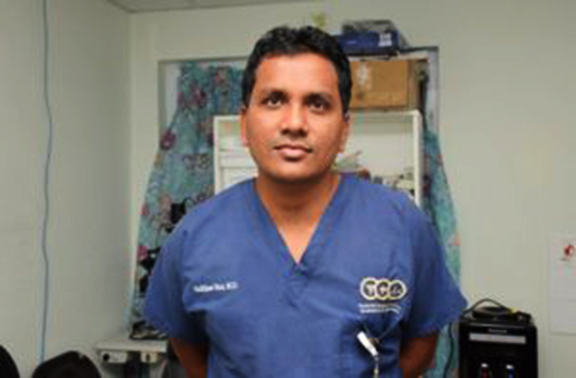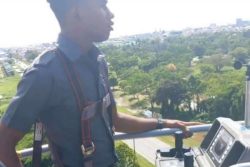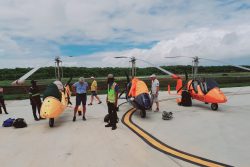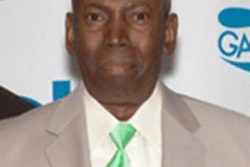The National Emergency Medical Services in Guyana responded to 15,630 medical emergencies between 2016 and 2020. This is according to the Director of the National Emergency Medical Services (EMS) in Guyana, Dr. Zulfikar Bux.
Dr. Bux, in a telephone interview with the Sunday Stabroek, said that since its implementation the National EMS has responded to approximately 15,630 medical emergencies reported via the Guyana Fire Service ‘912’ emergency hotline. Mentioning that the role of Emergency Medical Technicians (EMTs) is carried out by persons who have a passion and care for lives, the EMS Director said that young professionals should be encouraged to be a part of the career that impacts the lives of Guyanese. Dr. Bux who also holds the position as head of the accident and emergency department at the Georgetown Public Hospital, explained that being the first Emergency Medical Specialist in Guyana, his role since 2013 has been to develop the EMS system at the hospital. In doing so, he has helped with the training of nurses and officers to become emergency specialists.
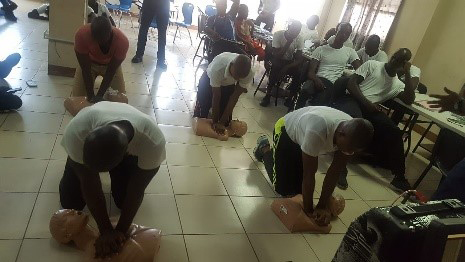
However, while having the response at the hospital improved, it became apparent that the response prior to the hospital was, and still is, somewhat lacking. Hence, the Fire Service and Police Service were trained in medical aid. He said that the capacity for pre-emergency response is limited because it is fairly new to Guyana. This system was started in 2016. A total of 89 Emergency Medical Technicians (EMTs) have been trained, along with nine emergency medical responders, 32 emergency medical dispatchers, 618 police officers, 48 ranks of the Customs Anti-Narcotic Unit (CANU), 21 surveyors from the Guyana Lands and Surveys Commission, 24 workers from the Mahaica-Mahaicony-Abary/Agricultural Development Authority (MMA/ADA), 115 firefighters and 165 staffers of the Guyana Water Incorporated (GWI).
These EMTs are the persons who are trained to go to the scene of accidents, fires and other medical emergencies to tend to the patients. He noted that at the scene, many patients may be in critical condition and thus, the EMTs are essentially life savers as they are the first to arrive and treat patients in need of emergency assistance. This saves time between the scene of the injury and the emergency room. In the emergency room doctors proceed with treatment as EMTs would have already provided the details (issues, current condition and intervention provided) of the patient prior to arrival. “For us in the emergency system time is life. The more time you can save, the more lives you can save,” Dr. Bux said. He disclosed that the EMS has had 17 deliveries and four successful resuscitations since 2016.
Road population
But while this system works well in the Georgetown and Region Four area, it requires significant improvement to be effective in the entire country. As an example, Dr. Bux explained that the EMTs provide efficient emergency responses to the road population, which is the population domiciled and interconnected by the Skeldon to Parika and Georgetown to Linden road networks. The road population accounts for between 70 to 80 per cent of the country’s population. A EMT team would therefore be able to respond efficiently to demands with the use of ambulances; conversely, EMTs do not have the logistical tools to serve the riverain and rural areas which require either aircraft, boats or all-terrain vehicles (ATVs). He noted that while there is a plan for these areas to be covered and provided with the necessary emergency aid, it is costly and time consuming because of the demands the regions hold. The Emergency Medical Specialist further added that the Ministry of Health intends to have the necessary utilities in place after a robust system is built for the current project, being the supply of ambulances for response via road. The planning for boat ambulances and air transport will be the next step, he said.
Dr. Bux also mentioned that not only is transportation an issue but the attitude of the public toward these responders is not supportive when equated with the specialty and quality of service that is being offered. According to Dr. Bux, the public’s behaviour towards teams even when executing life-saving interventions dampens the spirit of team members. Citing examples, Dr. Buz explained that rather than encouraging the team when doing their job, criticisms are often directed at first responders. In other cases crowds build and get so close that teams are impeded. In some instances the public even becomes physically abusive toward the service providers.
“Guyanese need to understand this is not going to be perfect from the start. These are guys that we would have had to train to be emergency technicians but we don’t have anybody who would’ve been doing this before,” Dr. Bux said and further explained that when he became a doctor he had other doctors to look up to but such is not the situation for these persons.
“These guys are taking a risk with themselves going out to dangerous areas and they are doing the best they can with what training they have had,” the doctor related. Other ways the public affects the EMTs’ performance is by having low levels of patience when teams are sent out to these emergencies. Dr. Bux informed that due to the difficulty with finding locations and traffic congestion, the EMTs are often criticized for the time they took to arrive at a scene. He explained that this is often because road users do not always cooperate by allowing the ambulances to pass unhindered. Dr. Bux cited specific operational challenges, such as, responders trying to navigate traffic whilst being provided with locations and directions in real time via phone. When the served public does not cooperate lives are being placed at severe risk, further compounding the functions of EMTs.
Dr. Bux said that in his position he has been trained to respond to every medical situation and the training for EMTs follows the same template. Persons who are trained in this field must have a total of five CSEC subjects and been given a police clearance before they will be interviewed and must show genuine interest in wanting to be a part of the team to provide the lifesaving service. These persons are then recruited and undergo rigorous training and tests before they write the practical and theory exam. If they pass this exam they can then be enrolled to do rotations in the ambulance system and thereafter they are a part of the team.
